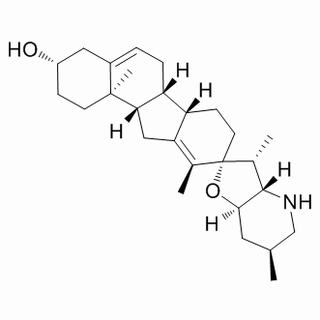Home
Products
Cyclopamine



| Product Name | Cyclopamine |
| Price: | $117 / 20mg |
| Catalog No.: | CN01031 |
| CAS No.: | 4449-51-8 |
| Molecular Formula: | C27H41NO2 |
| Molecular Weight: | 411.6 g/mol |
| Purity: | >=98% |
| Type of Compound: | Alkaloids |
| Physical Desc.: | Powder |
| Source: | The herbs of Veratrum nigrum L. |
| Solvent: | Chloroform, Dichloromethane, Ethyl Acetate, DMSO, Acetone, etc. |
| SMILES: | O[C@H]1CC[C@]2(C(=CC[C@@H]3[C@@H]2CC2=C(C)[C@]4(CC[C@@H]32)O[C@H]2[C@H]([C@H]4C)NC[C@H](C2)C)C1)C |
| Contact us | |
|---|---|
| First Name: | |
| Last Name: | |
| E-mail: | |
| Question: | |
| Description | Cyclopamine is a Hedgehog (Hh) pathway antagonist with an IC50 of 46 nM in the Hh cell assay. |
| Target | IC50: 46 nM (Hedgehog, in Hh cell assay)[1] |
| In Vitro | Treatment with small molecule Hh inhibitors such as HhAntag and the natural product Cyclopamine, both binding to Smo, induces tumor remission in a genetic mouse model of medulloblastoma[1]. Cyclopamine is a Hedgehog (Hh) pathway antagonist. Cyclopamine suppresses cell growth. Cyclopamine (3 μM) suppression of Hh pathway activity and growth in digestive tract tumour cell lines correlates with expression of PTCHmRNA[2]. Cyclopamine is a steroidal alkaloid that inhibits Hh signalling through direct interaction with Smo[3]. |
| In Vivo | Cyclopamine causes durable regression of xenograft tumors. Tumors in Cyclopamine-treated animals, regress completely by 12 days[2]. Cyclopamine (1.2 mg) treatment blocks tumour formation of human pancreatic adenocarcinoma cells after transplantation into nude mice[3]. |
| Cell Assay | Cells are cultured in triplicate in 96-well plates in assay media to which 5E1 monoclonal antibody, ShhNp and/or Cyclopamine (3 μM) are added at 0 h at concentrations indicated in the main text. Viable cell mass is determined by optical density measurements at 490 nm (OD490) at 2 and 4 days using the CellTiter96 colorimetric assay. Relative growth is calculated as OD (day 4)-OD (day 2)/OD (day 2)[2]. |
| Animal Admin | Mice[3] A total of 0.1 mL Hanks’ balanced salt solution and matrigel (1:1) containing 2×106 cells is injected subcutaneously into CD-1 nude mice. Tumors are grown for 4 days to a minimum volume of 125 mm3; treatment is initiated simultaneously for all subjects. Mice are injected subcutaneously with vector alone (triolein:ethanol 4:1 v/v) or a Cyclopamine suspension (1.2 mg per mouse in triolein:ethanol 4:1 v/v) daily for 7 days. At the end of the treatment period, tumours are excised from mice, weighed and then fixed for 3 h at 4°C with 4% paraformaldehyde, embedded in paraffin wax and sectioned (6 µm). Apoptotic cells are identified by TUNEL using recombinant Tdt. Sections are then counterstained with eosin. Eight ×20-magnified fields from regions corresponding to the exterior, middle and interior of two control and two cyclopamine-treated tumours are chosen at random. We counted the number of TUNEL-positive nuclei manually. Haematoxylin/eosin staining is done. |
| Density | 1.1±0.1 g/cm3 |
| Boiling Point | 550.8±50.0 °C at 760 mmHg |
| Flash Point | 286.9±30.1 °C |
| Exact Mass | 411.313721 |
| PSA | 41.49000 |
| LogP | 5.44 |
| Vapour Pressure | 0.0±3.4 mmHg at 25°C |
| Storage condition | 2-8°C |